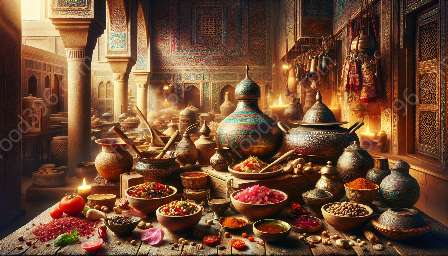The cuisine of the Middle East is a mosaic of rich flavors, vibrant colors, and tantalizing aromas. This culinary tradition has been shaped by centuries of history, cultural exchange, and regional diversity. At the heart of Middle Eastern cuisine are its traditional ingredients and cooking techniques, which have been passed down through generations, reflecting a deep connection to the land and its bounty. In this exploration, we delve into the allure of Middle Eastern ingredients and the artistry of its cooking methods, while also uncovering the historical roots that have shaped this distinctive culinary heritage.
Origins of Middle Eastern Cuisine
Before delving into the specific ingredients and cooking techniques, it is essential to understand the historical context that has given rise to Middle Eastern cuisine. The Middle East, geographically located at the crossroads of Europe, Asia, and Africa, has been a melting pot of diverse cultures, trade routes, and agricultural practices for millennia. As a result, the region's culinary landscape reflects a rich tapestry of influences from ancient civilizations, including the Mesopotamians, Egyptians, Phoenicians, Persians, and Ottomans. Each civilization has left its indelible mark on the ingredients, culinary traditions, and cooking techniques that define Middle Eastern cuisine today.
Culinary History of the Middle East
The history of Middle Eastern cuisine is deeply intertwined with the development of agriculture and trade, as well as the progression of culinary arts and techniques. Ancient Mesopotamia, often referred to as the cradle of civilization, introduced the world to key agricultural products such as wheat, barley, and dates, which form the foundation of many Middle Eastern dishes. The meticulous cultivation of ingredients, such as olive oil, figs, pomegranates, and aromatic spices, laid the groundwork for the region's culinary sophistication. The exchange of goods along the Silk Road and other trade routes further diversified the Middle Eastern pantry, introducing new flavors and culinary techniques from distant lands.
Signature Middle Eastern Ingredients
At the core of Middle Eastern cuisine are a myriad of iconic ingredients that shape its distinct flavors and textures. From sumptuous spices to luscious fruits and robust grains, these ingredients are the building blocks of countless traditional Middle Eastern dishes. A quintessential pantry of Middle Eastern ingredients may include:
- 1. Spices: Cumin, coriander, cardamom, turmeric, sumac, and za'atar
- 2. Aromatic Herbs: Mint, parsley, cilantro, dill, and tarragon
- 3. Fruits: Pomegranates, dates, figs, apricots, and olives
- 4. Grains: Rice, bulgur, couscous, and various types of bread
- 5. Nuts and Seeds: Almonds, pistachios, pine nuts, and sesame seeds
- 6. Dairy: Yogurt, labneh, and various cheeses
- 7. Vegetables: Eggplant, tomatoes, bell peppers, zucchini, and chickpeas
These ingredients are not only esteemed for their culinary versatility but also hold cultural and symbolic significance in Middle Eastern societies. Whether employed in savory stews, vibrant salads, or delectable desserts, these ingredients form the cornerstone of Middle Eastern gastronomy, embodying a harmonious blend of tradition and innovation.
Cooking Techniques and Culinary Practices
The art of Middle Eastern cooking encompasses a wide array of techniques and practices that have been refined over centuries. From elaborate spice blends to the meticulous preparation of kebabs and the delicate art of pastry-making, Middle Eastern culinary traditions are as diverse as the region itself. Some notable cooking techniques and culinary practices include:
- 1. Spice Blending: The skillful combination of spices to create complex and aromatic blends, such as ras el hanout and baharat
- 2. Grilling and Roasting: The use of open flames and traditional clay ovens to impart smoky flavors and tender textures to meats, vegetables, and flatbreads
- 3. Pickling and Fermentation: Preserving vegetables, fruits, and dairy products through traditional methods of pickling and fermentation
- 4. Pastry and Sweets: The art of creating exquisite pastries, such as baklava, ma'amoul, and kanafeh, through intricate filo dough and sweet fillings
- 5. Slow Cooking: Simmering stews, tagines, and soups over low heat to develop deep, complex flavors
These techniques not only showcase the culinary ingenuity of the Middle Eastern kitchen but also reflect the region's reverence for fresh, high-quality ingredients and the art of bringing people together through food.
Evolution of Middle Eastern Cuisine
Over the centuries, Middle Eastern cuisine has undergone a dynamic evolution, embracing new ingredients, culinary techniques, and cultural influences while preserving its deep-rooted traditions. The exchange of culinary knowledge with neighboring regions and global migration patterns has enriched the Middle Eastern culinary tapestry, resulting in a vibrant and contemporary gastronomic landscape. As Middle Eastern cuisine continues to captivate the world with its flavors and aromas, it remains a testament to the enduring legacy of its ingredients, cooking techniques, and historical roots.
Embracing Middle Eastern Culinary Heritage
Exploring the traditional ingredients and cooking techniques of the Middle East unveils a captivating blend of flavors, history, and cultural significance. The essence of Middle Eastern cuisine resides in its ability to evoke a sense of tradition, hospitality, and culinary artistry, making it a timeless and cherished culinary tradition that continues to inspire and delight gastronomes around the globe.


